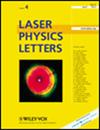基于 DWT-SVD 的加密计算机生成全息图水印技术
IF 1.4
4区 物理与天体物理
Q3 OPTICS
引用次数: 0
摘要
为了提高图像加密和隐藏的安全性和隐蔽性,提出了一种基于离散小波变换(DWT)和奇异值分解(SVD)的加密计算机全息图(CGH)水印技术。首先,对要加密的图像进行编码并转换成二进制实值 CGH。然后将加密的 CGH 作为水印嵌入主图像中,实现图像加密和隐藏。解密时,首先使用反 DWT-SVD 和正确的密钥提取加密的 CGH 水印。随后,应用正确的光学密钥进行计算全息再现,即可获得解密后的图像。该方法将计算全息编码和光学密钥引入数字水印技术,结合了 DWT 和 SVD 的特点,解决了 SVD 算法误报率高的问题。仿真结果表明,将 CGH 引入水印技术后,图像加密和隐藏的安全性大大提高,尤其是在水印攻击和噪声的鲁棒性方面。该方法可应用于数字图像和印刷图像的版权保护和防伪领域。本文章由计算机程序翻译,如有差异,请以英文原文为准。
Cryptographic computer generated hologram watermarking technology based on DWT-SVD
To improve the security and invisibility of image encryption and concealment, an encrypted computer generated hologram (CGH) watermarking technology based on discrete wavelet transform (DWT) and singular value decomposition (SVD) is proposed. Firstly, the image to be encrypted is encoded and converted into a binary real-valued CGH. The encrypted CGH is then embedded into the host image as a watermark, implementing image encryption and concealment. During decryption, the encrypted CGH watermark is first extracted using the inverse DWT-SVD and the correct keys. Subsequently, the decrypted image is obtained by applying the correct optical key for computational holographic reproduction. The method introduces computational holographic coding and optical keys into the digital watermarking technique and combines the characteristics of DWT and SVD, solving the problem of the high false positive rate of the SVD algorithm. Simulation results show that the security of image encryption and concealment is greatly improved with the introduction of CGH into watermarking technology, especially in terms of robustness to watermark attacks and noise. This method can be applied in the fields of copyright protection and anti-counterfeiting for digital and printed images.
求助全文
通过发布文献求助,成功后即可免费获取论文全文。
去求助
来源期刊

Laser Physics Letters
物理-仪器仪表
CiteScore
3.30
自引率
11.80%
发文量
174
审稿时长
2.4 months
期刊介绍:
Laser Physics Letters encompasses all aspects of laser physics sciences including, inter alia, spectroscopy, quantum electronics, quantum optics, quantum electrodynamics, nonlinear optics, atom optics, quantum computation, quantum information processing and storage, fiber optics and their applications in chemistry, biology, engineering and medicine.
The full list of subject areas covered is as follows:
-physics of lasers-
fibre optics and fibre lasers-
quantum optics and quantum information science-
ultrafast optics and strong-field physics-
nonlinear optics-
physics of cold trapped atoms-
laser methods in chemistry, biology, medicine and ecology-
laser spectroscopy-
novel laser materials and lasers-
optics of nanomaterials-
interaction of laser radiation with matter-
laser interaction with solids-
photonics
 求助内容:
求助内容: 应助结果提醒方式:
应助结果提醒方式:


